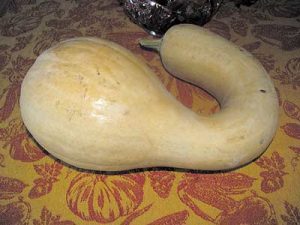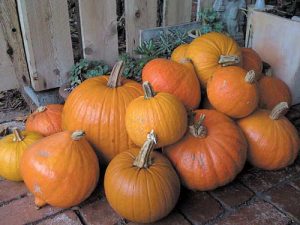September 29, 2016
Pumpkin Pie
 By Mary Schricker Gemberling
By Mary Schricker Gemberling
“It was October again … a glorious October, all red and gold, with mellow mornings when the valleys were filled with delicate mists as if the spirit of autumn had poured them in for the sun to drain — amethyst, pearl, silver, rose, and smoke-blue. The dews were so heavy that the fields glistened like cloth of silver and there were such heaps of rustling leaves in the hollows of many-stemmed woods to run crisply through.”
-L.M. Montgomery
(author of Anne of Green Gables)
Even though the official Autumnal Equinox is still ten days away, the earlier sunsets and cooler temperatures have me anxious for all things ‘fall’! Even the grass and plants in the yard are still mostly green, but the surrounding fields of corn and beans are changing to varying shades of gold. The burning bushes have tinges of red and the very tops of our maple trees are just beginning to turn colors.
Tired of summer salads and lighter meals, I crave my favorite fall dishes. Soups and stew, baked chicken, anything apple and stuffed pork chops all have my mouth watering, but my absolute favorite is pumpkin pie!
In addition to the great taste of pumpkin, I realized I knew little about this vegetable….or is it a fruit? A fruit is defined as being the part of the plant which contains seeds. The average pumpkin contains about a cup of seeds, so it is most definitely a fruit!
Pumpkins come in a rainbow of colors, shapes and sizes. Some can be carved or displayed for decoration, and others are fabulous for culinary uses. A pumpkin is a member of the cucurbit family, which also includes squash, cucumbers, luffas, watermelons and melons. Most of the plants in this family are vines, but there are a few exceptions.
Pumpkins and squash are believed to have originated in the ancient Americas. These early pumpkins were not the traditional round orange upright Jack-O-lantern fruit we think of today. This crooked neck variety, long before the emergence of maize, was cultivated along river and creek banks with sunflowers and beans. The early Native Americans roasted pumpkin strips over campfires to use as a food source for the long winters. They also ate pumpkin seeds and used them for medicine. The blossoms were added to stews and the dried pumpkin could be stored and ground into flour. The shells were dried and used as bowls and containers to store the grain, beans and seeds. In early colonies, pumpkin shells were used as a template for haircuts to ensure a round, uniform cut. As a result of this practice, New Englanders were sometimes referred to as ‘pumpkin heads’!
in the ancient Americas. These early pumpkins were not the traditional round orange upright Jack-O-lantern fruit we think of today. This crooked neck variety, long before the emergence of maize, was cultivated along river and creek banks with sunflowers and beans. The early Native Americans roasted pumpkin strips over campfires to use as a food source for the long winters. They also ate pumpkin seeds and used them for medicine. The blossoms were added to stews and the dried pumpkin could be stored and ground into flour. The shells were dried and used as bowls and containers to store the grain, beans and seeds. In early colonies, pumpkin shells were used as a template for haircuts to ensure a round, uniform cut. As a result of this practice, New Englanders were sometimes referred to as ‘pumpkin heads’!
- Pumpkins are very nutritious and fit well into a health-conscious diet. They are low in calories and sodium but high in fiber and beta-carotene. The seeds are high in protein, iron and B vitamins.
- Pumpkins keep eyesight sharp. A cup of cooked, mashed pumpkin contains more than 200 percent of your recommended daily intake of vitamin A, which aids vision.
- Pumpkins, an often-overlooked source of fiber, can help with weight loss. One cup, only 49 calories, can keep you feeling fuller longer!
- Nuts and seeds, including those of pumpkins, are naturally rich in certain plant-based chemicals that have been shown in studies to reduce LDL or “bad cholesterol”.
- Pumpkins may reduce cancer risk. Like their orange
counterparts the sweet potato, carrot and butternut squash, pumpkins boast the antioxidant beta-carotene, which may play a role in cancer prevention according to the National Cancer Institute. - Pumpkins protect the skin. The same free-radical-neutralizing powers of the carotenoids in pumpkin may help keep the skin wrinkle free.
- Pumpkin seeds can boost your mood. They are rich in the amino acid tryptophan, which is important in the production of serotonin, one of the major contributors when it comes to our mood.
- Pumpkins can help after a hard workout. Just like bananas, pumpkins have the refueling nutrient potassium, natures energy bar! A little extra potassium helps restore the body’s balance of electrolytes after a heavy workout and keeps muscles functioning at their best.
- Pumpkins can boost your immune system. Whether vitamin C can really ward off colds is still being debated, but pumpkins are a solid source of this essential nutrient.
 Over 1.5 billion pounds of pumpkin are produced each year in the United States. The top pumpkin-producing states are Illinois, Ohio, Pennsylvania, and California. Pumpkins are also grown on every continent except Antarctica, but the ‘Pumpkin Capital of the World’ is just 100 miles southeast of the Quad Cities. Morton Illinois, a town of just over 16,000 people processes 95 percent of the world’s canned pumpkin at the Libby’s plant. Or to put it in perspective, enough pumpkin to bake more than 50 million pies!
Over 1.5 billion pounds of pumpkin are produced each year in the United States. The top pumpkin-producing states are Illinois, Ohio, Pennsylvania, and California. Pumpkins are also grown on every continent except Antarctica, but the ‘Pumpkin Capital of the World’ is just 100 miles southeast of the Quad Cities. Morton Illinois, a town of just over 16,000 people processes 95 percent of the world’s canned pumpkin at the Libby’s plant. Or to put it in perspective, enough pumpkin to bake more than 50 million pies!
And speaking of pies, from now on I will have to bake twice as many. I know I will be having seconds, just to make sure I am eating healthy!!
Mary, a former educator and Seniors Real Estate Specialist, is the author of three books, Hotel Blackhawk; a Century of Elegance, The West End Kid, and Labor of Love; My Personal Journey through the World of Caregiving (available at www.amazon.com )
Surprising facts about pumpkins:
- The word “pumpkin” showed up for the first time in the fairy tale, Cinderella.
- The original jack-o-lanterns were made with turnips and potatoes by the Irish.
- The world’s largest pumpkin was more than five feet in diameter and weighed over 1,800 pounds.
- The largest pumpkin pie ever baked weighed 2,020 pounds.
- Each pumpkin has about 500 seeds.
- Pumpkins are 90% water.


